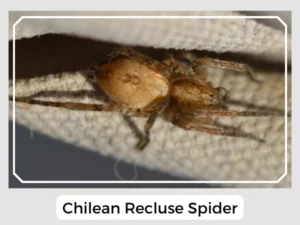Imagine a spider called the Chilean recluse. It’s known to be the most dangerous of its kind because of its strong venom. While its name hints at its home in Chile, you can also find it in places like Ecuador, Argentina, and Brazil. Curious to know more?
They are contained in a silken sac and at a time 40 to 50 of them are hatched.
The spiderlings emerge from the sac within a month’s time and in a short span start being on their own.
Their webs like other recluse spiders are built in an irregular fashion, comprising of threads arranged in a disorderly fashion. These nocturnal spiders leave their webs during nighttime in order to hunt.
Yes, Chilean Recluse spiders do have venom. In fact, their venom is known to be strong and can affect humans.
Absolutely, Chilean Recluse spiders can bite. If they do, it might be uncomfortable and it’s a good idea to be cautious around them. Its bites can cause symptoms from mild irritation to severe skin cell death, leaving deep scars. While bites can be painless at first, they can grow significantly in severe cases. In Chile, over 30 years, 3% to 4% of bites were fatal. Ice packs and aloe vera gel can offer initial relief.
The Chilean Recluse plays a vital role in controlling the population of insects and other spiders within its habitat, ensuring a balanced ecosystem. Its nocturnal and solitary nature, coupled with its preference for undisturbed environments, makes it a fascinating subject of study.
Natural Predator: Smaller birds, wasps, cats, and other spiders are known to prey on the Chilean Recluse, highlighting the spider’s place within the food web.
Prey-Predator Dynamics: The Chilean Recluse’s venomous bite is a critical component of its survival, enabling it to immobilize prey. Conversely, its natural predators help regulate its population, ensuring ecological balance.
Relationship with Humans: While the Chilean Recluse prefers secluded environments, it is not uncommon to find them in close proximity to human dwellings. As a result, interactions are inevitable, necessitating awareness and caution to prevent bites and their potentially severe consequences.
| Other names | Corner spider, brown spider |
| Lifespan | 2 to 4 years |
| Distribution | Chile, Argentina, Uruguay, Peru, Ecuador, southern and eastern Brazil as well as parts of Los Angeles, Massachusetts, Vancouver, and Florida. It has even been found in Australia |
| Habitat | Human dwellings, alongside wood piles, garages, sheds, closets, and any area that is dry and undisturbed |
| Common predators | Smaller birds, wasps, cats, and other spiders |
| Diet | Insects and other spiders |
In summary, the Chilean Recluse spider, with its potent venom and secluded lifestyle, continues to captivate and caution those who cross its path.

Imagine a spider called the Chilean recluse. It’s known to be the most dangerous of its kind because of its strong venom. While its name hints at its home in Chile, you can also find it in places like Ecuador, Argentina, and Brazil. Curious to know more?
They are contained in a silken sac and at a time 40 to 50 of them are hatched.
The spiderlings emerge from the sac within a month’s time and in a short span start being on their own.
Their webs like other recluse spiders are built in an irregular fashion, comprising of threads arranged in a disorderly fashion. These nocturnal spiders leave their webs during nighttime in order to hunt.
Yes, Chilean Recluse spiders do have venom. In fact, their venom is known to be strong and can affect humans.
Absolutely, Chilean Recluse spiders can bite. If they do, it might be uncomfortable and it’s a good idea to be cautious around them. Its bites can cause symptoms from mild irritation to severe skin cell death, leaving deep scars. While bites can be painless at first, they can grow significantly in severe cases. In Chile, over 30 years, 3% to 4% of bites were fatal. Ice packs and aloe vera gel can offer initial relief.
The Chilean Recluse plays a vital role in controlling the population of insects and other spiders within its habitat, ensuring a balanced ecosystem. Its nocturnal and solitary nature, coupled with its preference for undisturbed environments, makes it a fascinating subject of study.
Natural Predator: Smaller birds, wasps, cats, and other spiders are known to prey on the Chilean Recluse, highlighting the spider’s place within the food web.
Prey-Predator Dynamics: The Chilean Recluse’s venomous bite is a critical component of its survival, enabling it to immobilize prey. Conversely, its natural predators help regulate its population, ensuring ecological balance.
Relationship with Humans: While the Chilean Recluse prefers secluded environments, it is not uncommon to find them in close proximity to human dwellings. As a result, interactions are inevitable, necessitating awareness and caution to prevent bites and their potentially severe consequences.
| Other names | Corner spider, brown spider |
| Lifespan | 2 to 4 years |
| Distribution | Chile, Argentina, Uruguay, Peru, Ecuador, southern and eastern Brazil as well as parts of Los Angeles, Massachusetts, Vancouver, and Florida. It has even been found in Australia |
| Habitat | Human dwellings, alongside wood piles, garages, sheds, closets, and any area that is dry and undisturbed |
| Common predators | Smaller birds, wasps, cats, and other spiders |
| Diet | Insects and other spiders |
In summary, the Chilean Recluse spider, with its potent venom and secluded lifestyle, continues to captivate and caution those who cross its path.
